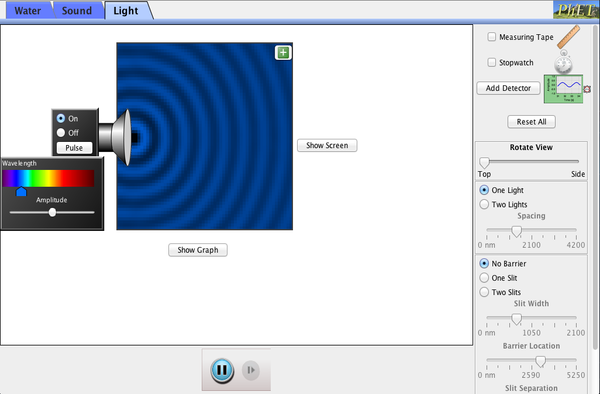Wave optics
- Light waves
- Interference
- Diffraction grating
- Single-slit diffraction
- Circular aperture diffraction
- Interferometers
Refraction, reflection and diffraction


- Refraction is the bending of light as it passes through regions where the effective speed of light changes

- Reflection happens when light changes direction upon striking a surface or different medium

-
Diffraction is the spreading of waves past small openings
- Can also refer to the bending of waves past small obstacles
-
Consider water waves going through a narrow opening
- Waves spread out into circular form after passing through the opening
- The same phenomenon is seen with light
Diffraction is evidence of the wave nature of light.

Diffracting waves interfere after passing through a double slit. The effects of interference can be seen on a screen at a distance beyond the slits.


- Laser light is coherent - all waves are in phase at the slit
- Waves have total constructive interference if they are in phase at the viewing screen
- Where you see the first bright spot, Δr = λ
- Where you see the second bright spot, Δr = 2λ
- Path lengths differ by an integer number of wavelength

The mth bright fringe lies where the wave from one slit travels m wavelengths farther than the wave from the other slit.

Using the small angle approximation, we can define the angle of the mth bright fringe.

Using the relationship from the small angle approximation, we can define the position of the mth fringe, defined as the distance from the central maximum.

We can use the difference between the positions of two consecutive fringes to define the fringe spacing.

Destructive interference will occur everywhere we add a half integer of the wavelength. We can use this fact to define the distance from the central bright maximum to the dark fringes.


Light of wavelength λ1 illuminates a double slit and interference fringes are seen on a screen. When light of a second wavelength λ2 illuminates the same double slit, with the same screen at the same distance, the fringes are closer together. Which statement is true?
A. λ2 is shorter than λ1
B. λ2 is longer than λ1
C. Cannot be determined from this information


Intensity of double-slit interference

We can use the amplitude function for two interfering waves, tailored to the double slit scenario, to write a function for amplitude.

We can use the fact that intensity goes as amplitude squared to write a function for the intensity of double slit diffraction. The final form writes intensity Idouble in terms of the intensity I1 = ca2 at the screen due to one wave, using a proportionality constant c.
The diffraction grating


A diffraction grating is similar to a double slit, but with many more slits. Each slit increases the amplitude of the light, so for N slits, the intensity goes as N2 times the intensity of the light from one slit.

Interference increases intensity of bright fringes by a factor of N. Energy is conserved, so the bright fringes tend to become very narrow.

Different wavelengths of light diffract by different degrees. Long wavelengths of light diffract more than short wavelengths. This makes diffraction gratings very useful for analyzing the wavelengths that make up a particular sample of light.

Light that is created from glowing gases carries characteristic wavelengths of light associated with photons emitted from excited electrons dropping to lower states. The wavelength of light corresponds to the difference in energy of the electron states. The light signature can be analyzed using a diffraction grating to identify the constituent elements in a gas.

Diffraction gratings are commonly used by astronomers to identify the gases that are present in stars.

The separation of light reflecting from a DVD arises from the light being diffracted by the many grooves on its surface.

© 2013 Pearson Education, Inc